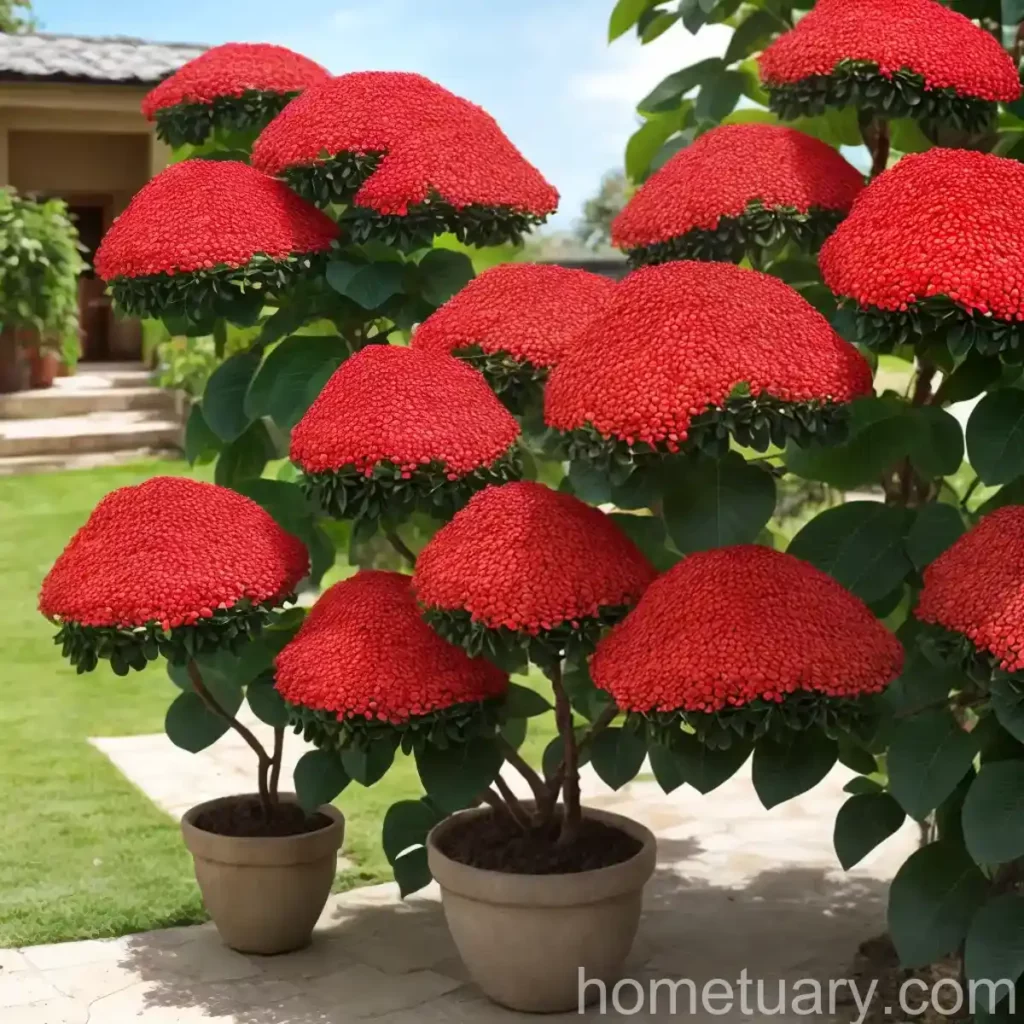The Marvelous Coralbush (Jatropha multifida)

The world of ornamental plants is vast and diverse, featuring a broad range of flora that astonishes with its unique beauty and adaptability. Among these remarkable plants stands the exceptional Coralbush, scientifically known as Jatropha multifida. This tropical wonder deserves a closer look for its stunning ornamental features, versatile uses, and fascinating characteristics that make it a popular choice among plant enthusiasts and landscaping professionals. In this comprehensive guide, we will delve into the captivating world of Coralbush, exploring its culture, uses, care tips, and much more.
What is Coralbush (Jatropha multifida)?
Coralbush, or Jatropha multifida, is a striking flowering shrub belonging to the Euphorbiaceae family. Originating from the tropical regions of Central and South America, as well as the Caribbean, this plant has garnered attention for its vibrant, deeply-lobed leaves and eye-catching coral-red flowers. The Coralbush is known for its rapid growth and ability to thrive in various environmental conditions, making it a sought-after addition to gardens, landscapes, and indoor spaces.
Key Takeaways – Coralbush (Jatropha multifida)
Before diving into the specifics of cultivating and caring for Coralbush, let’s outline some key takeaways about this captivating plant:
- Plant Name: Jatropha multifida
- Common Names: Coralbush, Physic Nut, Guatemala Rhubarb
- Plant Type: Flowering shrub
- Family: Euphorbiaceae
- Native to: Central and South America, the Caribbean
- Growth Habits: Fast-growing, multi-stemmed, drought-tolerant
- Features: Deeply-lobed leaves, coral-red flowers, ornamental appearance
- Uses: Ornamental landscaping, medicinal purposes, wildlife gardens
- Special Characteristics: Tolerates poor soil, attracts pollinators, low maintenance
Now that we have a brief overview of Coralbush, let’s explore its culture, uses, and essential care requirements to ensure its successful growth and flourishing beauty.
Culture
Coralbush, or Jatropha multifida, has established itself as a beloved ornamental plant due to its remarkable cultural adaptability and stunning decorative value. Understanding the optimal conditions for its growth and development is crucial for cultivating thriving Coralbush specimens.
Uses
The Coralbush holds various uses, ranging from decorative and ornamental to practical and medicinal. Let’s delve into the diverse applications of this remarkable plant:
- Ornamental Landscaping: Coralbush is widely utilized in landscaping for its vibrant foliage and striking flowers, bringing a tropical flair to gardens, parks, and public spaces.
- Medicinal Purposes: Some traditional medicinal practices incorporate parts of the Coralbush for their believed therapeutic properties.
- Wildlife Gardens: Due to its ability to attract pollinators, including butterflies and bees, Coralbush is an excellent addition to wildlife-friendly gardens.
Water
Proper watering is crucial for the health and vitality of Coralbush plants. Although they boast a degree of drought tolerance, consistent watering is necessary, especially during the establishment phase and in periods of prolonged dryness.
- Establishment: Newly planted Coralbush specimens require regular watering to encourage robust root development and successful acclimatization to their new surroundings.
- Mature Plants: Once established, Coralbush generally thrives with moderate water, requiring supplemental irrigation during dry spells or when cultivated in containers.
Sunlight
Coralbush exhibits a preference for bright sunlight, thriving in locations that offer ample sunshine. When selecting a planting site or deciding on its placement in a garden or landscape, considering its sunlight requirements is essential.
- Sun Exposure: Full to partial sun exposure is ideal for Coralbush, ensuring that it receives at least 6 hours of direct sunlight each day.
- Shading: In exceptionally hot climates, providing some afternoon shade can be beneficial to prevent leaf scorching and maintain the plant’s overall health.
Fertilizer
Supplemental feeding with a balanced fertilizer can contribute to the vigorous growth and abundant flowering of Coralbush. By understanding the appropriate fertilization practices, enthusiasts can promote the best possible performance from their prized plants.
- Fertilizer Types: A well-balanced, slow-release fertilizer formulated for flowering shrubs is suitable for Coralbush plants.
- Application Frequency: Fertilize Coralbush in early spring, just before the onset of active growth, and once again in midsummer to sustain blooming and overall plant vigor.
Soil
The soil composition and quality play a significant role in the successful cultivation of Coralbush. Understanding the preferred soil conditions and making necessary amendments are crucial for ensuring its well-being.
- Well-draining Soil: Coralbush thrives in well-draining soils, preventing waterlogging and root rot.
- Soil pH: Slightly acidic to neutral pH levels (6.0-7.0) are suitable for Coralbush, ensuring proper nutrient uptake and overall plant health.
- Soil Amendments: Incorporating organic matter, such as compost, into the planting area can improve soil structure and nutrient availability for Coralbush.
Pruning
Pruning is a valuable maintenance practice that contributes to the overall health, appearance, and longevity of Coralbush. By following appropriate pruning techniques, enthusiasts can shape and revitalize their plants.
- Pruning Time: Perform pruning in late winter or early spring, before the onset of new growth, to remove any damaged, crossing, or overcrowded branches.
- Pruning Techniques: Utilize clean, sharp pruning shears to make precise cuts, promoting tidy growth and enhancing the plant’s aesthetic appeal.
Propagation
The propagation of Coralbush allows enthusiasts to expand their plant collection or share its beauty with others. Learning about effective propagation methods empowers individuals to multiply their prized Coralbush specimens.
- Propagation Methods: Coralbush can be propagated from stem cuttings, seeds, or by air layering, with each method offering distinct advantages and considerations.
- Optimal Timing: Spring or early summer is generally preferred for propagating Coralbush, aligning with the plant’s active growth period.
Container Popularity
Coralbush’s adaptability and ornamental charm make it a popular choice for container gardening. Whether on patios, balconies, or as indoor specimens, Coralbush in containers can bring a tropical touch to any space.
- Container Selection: Choose spacious containers with adequate drainage holes to accommodate Coralbush plants and promote healthy root development.
- Growing Medium: Utilize well-draining potting mixes rich in organic matter to provide the necessary support and nutrients for container-grown Coralbush.
Common Diseases
While generally resilient, Coralbush can occasionally encounter diseases that impact its growth and appearance. Recognizing common diseases and understanding preventive measures is essential for maintaining plant health.
Disease Diagnosis
- Leaf Spot: Characterized by dark spots or lesions on foliage, often caused by fungal pathogens favored by moist conditions. Maintain proper air circulation and avoid overhead watering to mitigate leaf spot.
- Powdery Mildew: This fungal disease presents as a powdery white coating on leaves, hindering plant growth. Improving air circulation and addressing any overcrowding can reduce powdery mildew occurrences.
Common Pests
Pest infestations, though infrequent, can affect Coralbush plants, requiring prompt intervention to prevent significant damage. Recognizing common pests and implementing control measures is crucial for preserving plant health.
Botanist’s Tips
To enhance successful cultivation and caretaking of Coralbush plants, consider incorporating the following botanist’s tips:
- Regular Monitoring: Observing Coralbush plants regularly allows for early detection of potential issues, such as pest infestations or disease development.
- Balanced Care: Strive to maintain well-balanced care practices, providing adequate water, sunlight, and nutrients to support the plant’s overall vitality.
Fun Facts
As we unravel the fascinating world of Coralbush, let’s uncover some intriguing fun facts about this extraordinary plant:
- Butterfly Magnet: Coralbush’s vibrant flowers attract butterflies, adding a delightful fluttering spectacle to gardens.
- Tropical Heritage: Hailing from tropical regions, Coralbush evokes an exotic allure and thrives in climates reminiscent of its native habitat.
- Ornamental Versatility: In addition to its use in landscapes, Coralbush can serve as an eye-catching focal point in tropical-themed gardens and architectural plantings.
Links to External Resources
For further information and resources related to Coralbush (Jatropha multifida), consider exploring the following links:
- Coralbush Plant Profile – The Spruce
- Jatropha multifida – Floridata
- Coralbush (Jatropha multifida) Guide – Gardening Know How
In conclusion, Coralbush, or Jatropha multifida, stands as an exemplary flowering shrub distinguished by its captivating beauty, adaptability, and ornamental versatility. Embracing its cultural preferences, potential uses, and essential care requirements allows plant enthusiasts to unlock the full potential of Coralbush, fostering its flourishing presence in gardens, landscapes, and indoor settings.















